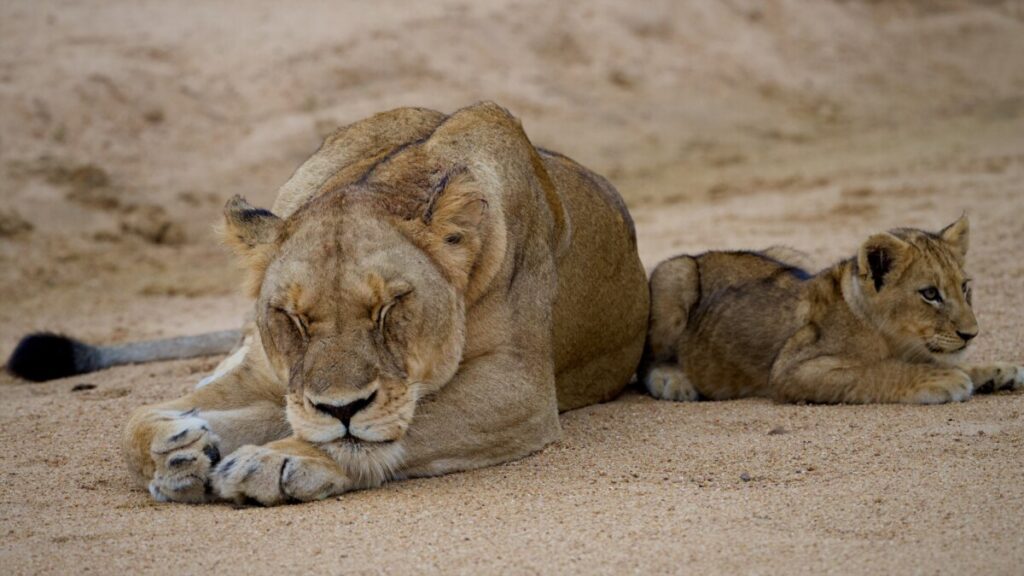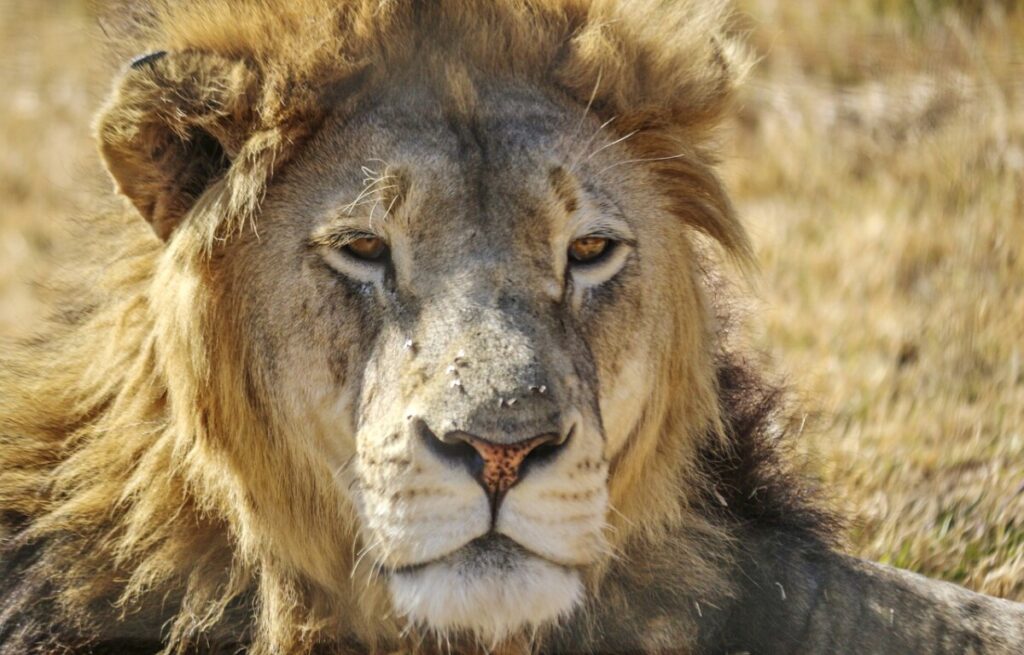Lions have long been regarded as the King of Beasts, with their regal appearance and powerful roar. As apex predators in the African savannahs, lions are some of the most recognizable species on earth. But just how big is this majestic animal? In this article, we will explore the size of one of nature’s most awe-inspiring creatures.
The lion (Panthera leo) is a member of the family Felidae and can be found throughout Africa and parts of India. Adult male lions typically weigh between 330 to 500 pounds depending on age and habitat conditions. They generally stand at 4 feet tall at the shoulder when fully grown. With an average length ranging from 6 to 9 feet, they possess impressive physical attributes that make them formidable hunters in the wild.
In addition to being large in stature, male lions also possess a thick mane which often makes them appear even larger than they actually are – creating an aura of strength and dominance over other animals in their environment. Indeed, there is no mistaking a lion’s presence when it strides through its natural landscape!

Anatomy And Morphology
Lions are among the largest felines in the world, with males reaching up to 260 kilograms (574 pounds) and females weighing around 150 kilograms (330 pounds). With such a great size comes an impressive physical presence.
Lions have characteristic manes that vary in color from light brown to black. The length of their mane is also unique to each lion; some males develop thick, full manes while others may only have small tufts behind their ears. In addition to these features, lions can be identified by their large paws and muscular tails which measure anywhere between 70-100 centimetres (27-39 inches).
The fur color of lions varies depending on the region they inhabit. African lions typically sport tawny or sandy coats, whereas Asiatic lions usually range from yellowish white to dark forest green. Despite significant regional variation in appearance and behavior, all species share similar characteristics when it comes to anatomy and morphology.
These cats possess incredibly powerful muscles and jaws which allow them to take down prey much larger than themselves.
In terms of body mass, male lions outweigh female counterparts significantly – yet both genders play important roles within their social groupings known as prides. Male lions act as protectors for the pride while females do most of the hunting; both work together towards a common goal despite differences in size and strength.
Habitat And Distribution
Lions are found across a wide range of habitats in Africa, India and parts of Asia. In the African continent, their habitat ranges from open plains to dense forests, with lion populations most commonly seen in savannas and grasslands.
Lions have also been observed living in areas where there is an abundance of water supply such as rivers, lakes and ponds. As for distribution range, lions can be found throughout much of sub-Saharan Africa and along the coast of western India.
The biggest threats to lion habitats are human activities such as deforestation, urbanization and poaching. These activities reduce prey availability and limit space for roaming. Furthermore, due to hunting pressures over many years, some subspecies like the Barbary lion have already become extinct while others face serious conservation challenges.
To protect remaining lion populations it is important that governments work together with local communities to ensure sufficient wildlife protection measures are implemented.
In recent times numerous organizations have taken up initiatives to save wild lions by creating protected areas or sanctuaries where they can live without fear of being hunted down or disturbed by humans. Such efforts must be continued if we wish to conserve these majestic animals for generations to come.
Hunting And Feeding Habits
Lions are apex predators, renowned for their powerful hunting skills and carnivorous diet. With remarkable agility and strength, they can capture prey up to three times their own weight. Prey selection is determined largely by the availability of food sources in a given area. Lions prefer large ungulates such as zebra and buffalo but may also feed on smaller mammals like rabbits if necessary.
Nocturnal hunting is common behavior among lions, allowing them to take advantage of cooler temperatures while avoiding detection from potential victims. This strategy involves stalking or ambushing unsuspecting animals before attacking with lightning speed. In addition to hunting, lions will scavenge carcasses left behind by other predators or even consume carrion found near human settlements.
Predation tactics used by lions vary based on the size and number of individuals involved in the hunt. A single lion has been known to attack full-grown adult antelopes whereas larger prides have taken down water buffalos and elephants. Regardless of what species is targeted, it’s clear that lions are skilled hunters capable of pursuing an abundance of different prey items.
Reproductive Behavior
Lion mating season typically begins in the late summer and continues until early winter. During this period, male lions establish territories and compete for females to mate with. The most dominant male will win over a pride of lionesses during competition, which can be very fierce at times. Mating rituals involve vocalizing and exhibiting aggressive behavior such as roaring or fighting other males.
After conception, gestation periods last approximately 110 days before cubs are born into the pride. It is quite common for female lions to give birth to litters ranging from one to four cubs; however, it is not uncommon for larger litters consisting of up to six cubs to be produced.
Although some newborn cubs may survive predation by hyenas or jackals, mortality rates remain high amongst lion cubs due to infanticide caused by intruding males taking over an existing pride’s territory.
In order for young cubs to have a chance at survival, they must learn how to hunt effectively as soon as possible after reaching adulthood around two years old. If successful, these juvenile lions will eventually leave their mother’s side and form new prides of their own elsewhere on the savanna.
Social Structure
At an average weight of 420 pounds and a length of 8.2 feet, lions are the second biggest cats in existence behind tigers. However, their size doesn’t prevent them from forming elaborate social structures that involve complex hierarchies. Lions reside in prides consisting of several related females and their cubs as well as one to four adult males.
The pride hierarchy is usually established by male dominance with older males typically exerting greater control than younger ones. Female lions become dominant over time due to age and experience, but they tend not to challenge the authority of the alpha males within the group.
The primary role for these large felines is to protect their young from potential predators like hyenas or other competing lions. Within each pride, all members cooperate to raise the cubs; both male and female adults participate in hunting activities while protecting their offspring from harm.
It’s common for subordinate adult males to assist mothers with caregiving duties such as providing food for cubs or even babysitting them when necessary. In addition, lionesses often form coalitions which can be beneficial in defending territories against intruders or attacking prey animals during hunts.
Lions have a highly organized social system that allows them to survive in challenging environments where resources may be scarce or difficult to obtain. By working together and establishing strong hierarchical relationships, lions are able to continue thriving despite their size disadvantage relative to some of their competitors.
Understanding how this powerful species interacts will help us better understand our own behavior and appreciate the importance of cooperation amongst different groups of people around the world today!

Conservation Status
Lions are considered an endangered species, with their population decreasing rapidly due to a variety of factors. Conservation efforts have been made in order to increase the numbers and protect the lions from further decline:
- Habitat loss has caused a decrease in prey availability for lions, making it difficult for them to survive; this led to conservation management strategies that aim at protecting animal habitats.
- Poaching is another serious threat to lion populations, as people hunt them for their fur or bones. To combat poaching, laws against hunting were implemented and enforcement increased.
- Disease can also cause a sharp drop in numbers; vaccination campaigns targeting specific diseases in lions were set up by organizations such as WWF International.
To date, these measures have not resulted in a significant rise in the number of wild lions but they have ensured that existing populations remain stable or slightly increase over time. The success of these initiatives depends on continued support from governments and local communities, which is essential if we want future generations to be able to enjoy seeing lions roaming freely across African savannas.
Interactions With Humans
The interactions between humans and lions have been a subject of great interest for centuries. Lions, due to their size and strength, are capable of posing a threat to humans when they come in contact with them.
The presence of lion populations near human settlements has caused many conflicts between the two species as well as other wildlife. These conflicts have ranged from minor altercations such as livestock predation to severe man-eater attacks that usually result in fatalities or injuries.
In recent times, various initiatives have been taken by governments and local communities to reduce these tensions. One of those is the implementation of lion safaris which provide an educational opportunity for people to observe wild lions in their natural habitats while assuring their safety at all times.
This activity also raises public awareness about the conservation status of this magnificent animal which is essential if we want future generations to admire it for years to come.
Despite current efforts, there are still cases where lion attacks on humans occur due to a variety of reasons including lack of prey availability or territorial disputes. Therefore, it is important for both sides to understand each other’s behavior and create peaceful coexistence protocols that can help mitigate any potential conflict situation.
Conclusion
Lions are majestic and awe-inspiring animals of the wild. From their impressive size to their robust social structure, these big cats have captivated human imagination for centuries.
Their bodies range from 4.5 – 6.5 feet in length and can weigh up to 550 pounds; males tend to be larger than females. These powerful predators typically inhabit savannas, grasslands and wooded areas, though they are found in a variety of habitats depending on region.
Lions typically hunt large ungulates such as antelope or zebra but will also scavenge when possible. Their reproductive behavior includes mating throughout the year with multiple partners, each female producing two or three cubs per litter after a gestation period of around 105 days. Prides usually consist of one dominant male and several related adult females along with their young offspring at any given time.
In recent years, lion populations have declined due to habitat loss, conflict with livestock owners and illegal poaching activities which has left them vulnerable to extinction in some parts of the world.
For example, while once lions roamed across much of Africa’s Savannah regions, that number is now estimated at below 20 thousand – down from over 200 thousand just 50 years ago according to an article by National Geographic magazine in 2019.
Conservation efforts must continue if we wish for our children’s grandchildren to experience this magnificent species within its natural environment for generations to come.
